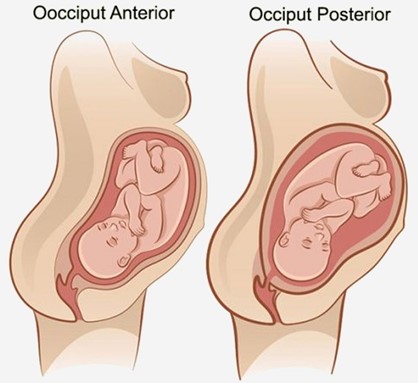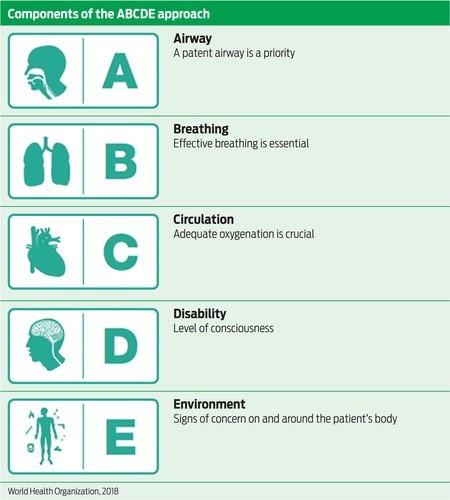A nurse is assisting with the care of a client who is in labor. The client's labor is difficult and prolonged and she reports a severe backache. Which of the following factors is a contributing cause of difficult, prolonged labor?
Fetal position is persistent occiput posterior.
Fetal attitude is in general flexion.
Fetal lie is longitudinal.
Maternal pelvis is gynecoid.
The Correct Answer is A
Choice A reason:
Fetal position is persistent occiput posterior is correct, as this position can cause difficult, prolonged labor and severe backache. The occiput posterior position means that the back of the fetal head is facing the maternal sacrum, which can result in poor alignment and descent, increased pressure on the maternal sacrum and nerves, and increased risk of perineal trauma. The nurse should encourage the client to change positions frequently, use pelvic rocking exercises, apply counterpressure to the sacrum, and administer analgesics as needed.
Choice B reason:
Fetal attitude is in general flexion is incorrect, as this attitude can facilitate normal labor and delivery. The fetal attitude refers to the degree of flexion or extension of the fetal head and limbs in relation to the fetal trunk. General flexion means that the fetal head is flexed on the chest, the arms are crossed over the chest, and the legs are flexed at the knees. This attitude allows the smallest diameter of the fetal head to pass through the birth canal.
Choice C reason:
Fetal lie is longitudinal is incorrect, as this lie can facilitate normal labor and delivery. The fetal lie refers to the relationship between the long axis of the fetus and the long axis of the mother. Longitudinal lie means that both axes are parallel, which allows for either a vertex (head-first) or a breech (butocks-first) presentation.
Choice D reason:
Maternal pelvis is gynecoid is incorrect, as this pelvis can facilitate normal labor and delivery. The maternal pelvis refers to the shape and size of the bony pelvis that affects the passage of the fetus. Gynecoid pelvis is the most common and favorable type for vaginal birth, as it has a rounded inlet, a wide pubic arch, and adequate outlet dimensions.

Nursing Test Bank
Naxlex Comprehensive Predictor Exams
Related Questions
Correct Answer is A
Explanation
Choice A reason: Massage the client's fundus is correct, as this is the first action the nurse should take according to the ABCDE priority framework. Saturating a perineal pad in 10 min indicates excessive bleeding and possible postpartum hemorrhage, which can compromise the client's airway, breathing, and circulation. Massaging the fundus can stimulate uterine contraction and reduce blood loss.
Choice B reason: Check the client's blood pressure is incorrect, as this is not the first action the nurse should take, although it is important to monitor for signs of shock. Checking the blood pressure does not address the cause of bleeding or prevent further blood loss.
Choice C reason: Administer oxytocin is incorrect, as this is not the first action the nurse should take, although it may be indicated later. Administering oxytocin requires a provider's order and may have adverse effects such as nausea,
vomiting, headache, or water intoxication. The nurse should first atempt to control bleeding by massaging the fundus and then administer oxytocin as ordered.
Choice D reason: Observe for pooling of blood under the butocks is incorrect, as this is not the first action the nurse should take, although it can help estimate blood loss. Observing for pooling of blood does not address the cause of bleeding or prevent further blood loss. The nurse should first atempt to control bleeding by massaging the fundus and then assess for other signs of hemorrhage.

Correct Answer is D
Explanation
Choice A reason:
Fetal head compression is incorrect, as this factor can cause early decelerations in the fetal heart rate. Early decelerations are symmetrical decreases in the FHR that mirror the contractions, which indicate fetal head compression and vagal stimulation. Fetal head compression occurs as the fetus descends into the birth canal and does not pose a threat to the fetal well-being.
Choice B reason:
Polyhydramnios is incorrect, as this factor can cause variable or late decelerations in the fetal heart rate, depending on the underlying cause. Polyhydramnios refers to an excessive amount of amniotic fluid, which can result from fetal anomalies, maternal diabetes, multiple gestation, or other conditions. Polyhydramnios can cause umbilical cord prolapse, uterine overdistension, or placental abruption, leading to reduced blood flow and oxygen delivery to the fetus.
Choice C reason:
Maternal fever is incorrect, as this factor can cause late decelerations in the fetal heart rate. Late decelerations are symmetrical decreases in the FHR that begin after the peak of the contraction and return to baseline after the contraction ends, which indicate uteroplacental insufficiency. Maternal fever can increase maternal and fetal metabolism and oxygen demand, leading to fetal hypoxia and acidosis.
Choice D reason:
Umbilical cord compression is correct, as this factor can cause variable decelerations in the fetal heart rate. Variable decelerations are abrupt decreases in the FHR that vary in onset, duration, and depth, which indicate umbilical cord compression and reduced blood flow to the fetus. Umbilical cord compression can occur due to cord prolapse, nuchal cord, short cord, or other causes. The nurse should reposition the client, administer oxygen, and prepare for delivery if indicated.
Whether you are a student looking to ace your exams or a practicing nurse seeking to enhance your expertise , our nursing education contents will empower you with the confidence and competence to make a difference in the lives of patients and become a respected leader in the healthcare field.
Visit Naxlex, invest in your future and unlock endless possibilities with our unparalleled nursing education contents today
Report Wrong Answer on the Current Question
Do you disagree with the answer? If yes, what is your expected answer? Explain.
Kindly be descriptive with the issue you are facing.
